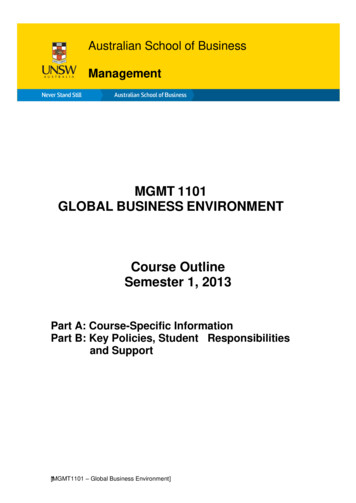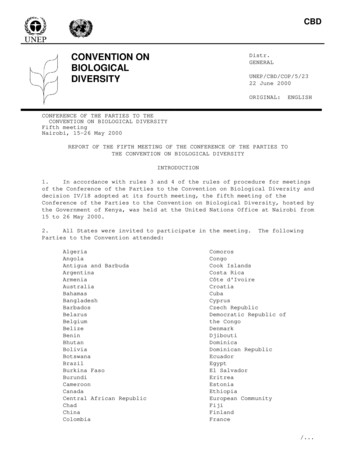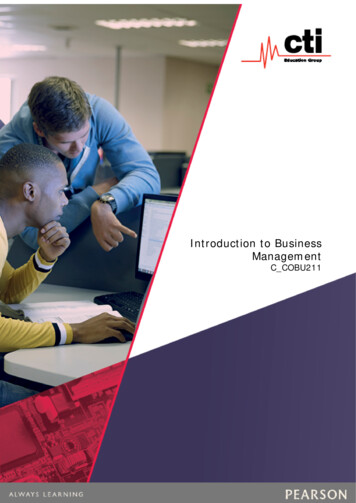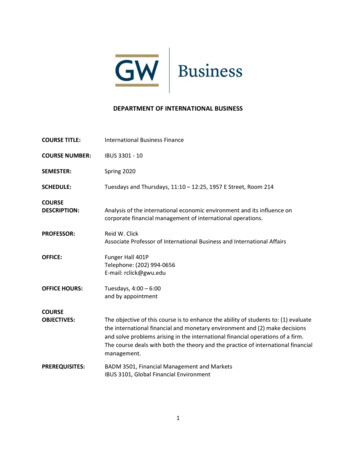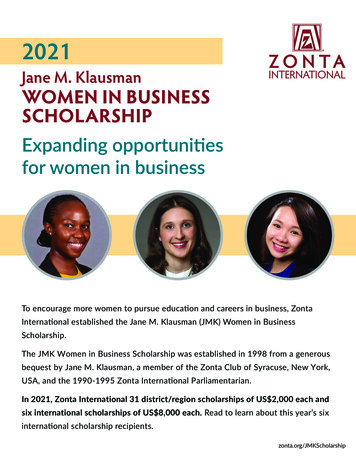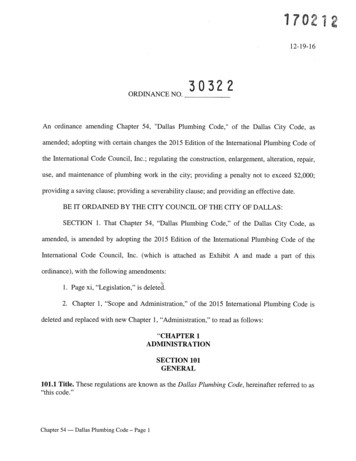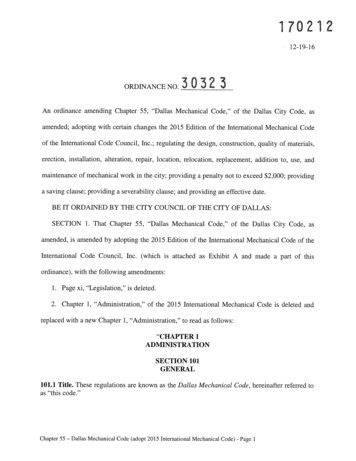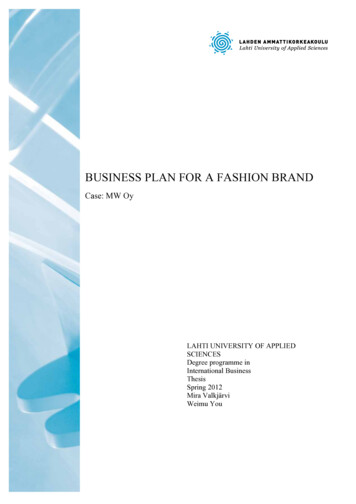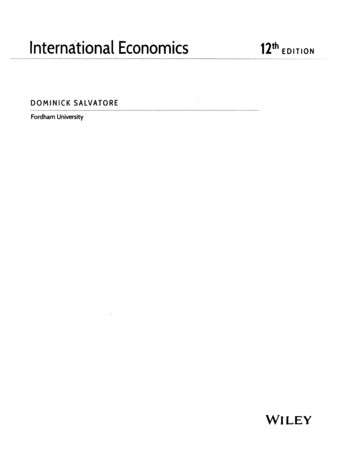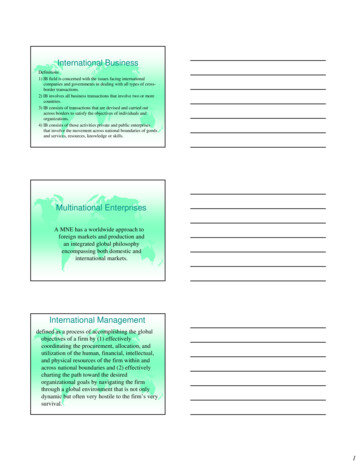
Transcription
International BusinessDefinitions1) IB field is concerned with the issues facing internationalcompanies and governments in dealing with all types of crossborder transactions.2) IB involves all business transactions that involve two or morecountries.3) IB consists of transactions that are devised and carried outacross borders to satisfy the objectives of individuals andorganizations.4) IB consists of those activities private and public enterprisesthat involve the movement across national boundaries of goodsand services, resources, knowledge or skills.Multinational EnterprisesA MNE has a worldwide approach toforeign markets and production andan integrated global philosophyencompassing both domestic andinternational markets.International Managementdefined as a process of accomplishing the globalobjectives of a firm by (1) effectivelycoordinating the procurement, allocation, andutilization of the human, financial, intellectual,and physical resources of the firm within andacross national boundaries and (2) effectivelycharting the path toward the desiredorganizational goals by navigating the firmthrough a global environment that is not onlydynamic but often very hostile to the firm’s verysurvival.1
International Trade: When a firm exports goodsor services to consumers in another country.Foreign Direct Investment: When a firm investsresources in business activities outside its homecountry.The Globalization of the WorldEconomyu Globalizationof marketsu Globalization of productionu Decline of barriers to trade (WTO)u Increased technological capabilitiesu 60,000 international firms with 500,000foreign affiliates that generate 11 trillion insales in 1998GlobalizationuuuuTrade and investment barriersare disappearing.Perceived distances areshrinking due to advances intransportation andtelecommunications.Material culture is beginningto look similar.National economies merginginto an interdependent globaleconomic system.2
Globalization: Pros& Consu Prosu– Increased revenueopportunity throughglobal sales.– Reduced costs byproducing in ‘low cost’countries.Cons– Different nations differentproblems.– Similarities between nationsmay be superficial.– Global planning may beeasy, but global executionis not.What is “Globalization”?Markets“The shift toward amore integrated andinterdependent worldeconomy.”ProductionGlobalization of Marketsu“Merging of historically distinct and separate nationalmarkets into one huge global marketplace.”– Facilitated by offering standardized products:CiticorpCoca-ColaSony PlayStationMcDonalds– Does not have to be a big company to participate:Over 200,00 U.S. companies with less than 100 employees hadforeign sales in 2000.3
The Largest Global ndustrial GoodsGoods andandMaterialsMaterials44CommoditiesCommodities suchsuch asasaluminum,aluminum, oiloil andand wheat.wheat.4Industrial productsproducts suchsuch asas4Industrialmicroprocessors,microprocessors, aircraft.aircraft.4Financial4Financial assetsassets suchsuch asasU.S.U.S. TreasuryTreasury billsbills andandEurobonds.Eurobonds.Globalization of productionu Refersto sourcing of goods and servicesfrom locations around the world to takeadvantage of– Differences in cost or quality of the factors ofproductionLaborLandCapitalGlobalization of Productionu “Thesourcing of goods andservices from locationsaround the globe to takeadvantage of nationaldifferences in the cost andquality of factors ofproduction (labor,energy, landand capital).”u Companies hope to lowertheir overall cost structureand/or improve the quality orfunctionality of their productoffering - increasing theircompetitiveness.“Global Products”4
Volume of world trade and production,1950-2002Fig: 1.1Macro FactorsDecline inin nologicalTechnologicalChangeChangeGeneral Agreement on Tariffs andTradeMember states (140) in eight negotiating ‘rounds’worked to lower barriers to the free flow ofgoods and services.In the most recent round, the Uruguay Round,nations agreed to enhanced patent, copyright andtrademark protections and established theWorld Trade Organization.5
Average Tariff Rates onManufactured Products as Percent Table 1.1Fewer FDI RestrictionsBetween 1991 and 2000of the 1,121 changes worldwide in lawsgoverning FDI, 95% created a morefavorable investment environment.During 2000, 69 countries made 150changes to FDI regulations, 147 or 98%were more favorable to investment.The Growth of World Trade andOutput25002000Trade1500T radeO utput1000500GDP0195019601970198019902000Figure 1.16
Percentage share of total FDIstockFig: 1.3The Role of TechnologicalChangeuuMicroprocessors andTelecommunicationsThe Internet and WorldWide WebWorldwide E-Commerce GrowthForecast800070006000R e s t o f W o r ld5000L a t in A m e r ic a40003000W .E ur o p eA s ia P a c if ic20001000N o r t h A m e r ic a020002001200220032004Figure 1.27
The Shrinking Globe1500-1840Best average speed ofhorse-drawn coaches andsailing ships, 10mph.1850-1930Steam locomotives average 65mph.Steamships average 36mph.1950sPropeller aircraft300-400 mph.Figure 1.21960sJet passenger aircraft500-700mph.Implications for Productionand Market GlobalizationProductiondispersed toeconomicallocations due totransportationand communicationadvances.NewNew marketsmarketsopenedopened throughthrough WWW.WWW.JetJet aircraftaircraft movemovepeoplepeople andand goods.goods.GlobalGlobal mediamedia creatingcreatingaa worldwideworldwide culture.culture.The Changing Paradigm of theGlobal Economyu Old:– U.S. dominance of the world economy and world trade.– U.S. dominance in world FDI.– U.S. firms dominance of international business.– ½ of the world economies (Communist dominated) were offlimits to western businesses.8
The Changing Pattern of WorldOutput and TradeOutput measured by GNP.COUNTRYSH ARE OFW O R L D O U T PU T200 0SH ARE OFW O R L D E X PO R T S200 04 0 .3 %27%1 2 .3 %5 .51 4 .27 .5 49 .7 (W . G e r.)7 .38 .7F ra nce6 .35 .24 .7U nite dK in g d omI ta ly6 .54 .13 .73 .44 .13 .7Canada3 .02 .04 .4C h inaNA3 .23 .9 2S o uth K or e aNA1 .42 .7U nite d S ta te sSH ARE OFW O R L D O U T PU T1963JapanG e r m a nyTable 1.2Percentage Share of Total FDI Stock,1980-20004540353025198020199015200010J apanF ra nceNetherlandsU .S .A .Germany0U.K.5D e v.C o u n t r ie sFigure 1.4FDI Inflows, 1988-2000( Billions)10 0 0800600400D e v e lo p e d C o u n tr ie sD e v e lo p in g C o u n tr ie sU n ite d S ta te sC h in a2000Figure 1.59
The National Composition of theLargest 813Germany8.1.912.712Table 1.3The Changing World Orderu Thefall of Communism in Eastern Europe andthe former Soviet Union.u Czechoslovakia has divided itself into two states.u Yugoslavia has divided into 5 (often warring)successor states.u Pro-democracy movement (suppressed) inChina.u Latin America has seen both democracy and freemarket reforms.Globalizationu Jobsand Income– Firms move jobs to low costcountries.– Countries specialize inefficiently produced goodsand import those they cannot efficiently produce.– Increases income in lessdeveloped countries.– May lead to incomeinequality.uLabor Policies and theEnvironment– Firms move to countries withweak laws.– Economic progress leads tostronger laws.– By creating wealth andincentives for technologyimprovements, world will bebetter.– Tie strong laws to internationalagreements.– Firms are not amoral.10
Environmental Performance IndexEnvironmental Performance andBulgariaJamaicaKoreaChinaS.AfricaIndiaTunisia TrinidadKenya Ethiopia5.0678910Income Index11Figure 1.6Globalization debate-Conu Destroysmanufacturing jobs in wealthy,advanced countriesu Wage rates of unskilled workers in advancedcountries declinesu Companies move to countries with fewer laborand environment regulationsu Loss of sovereigntyGlobalization and NationalSovereigntyUnder the new system, many decisions that affect billions ofpeople are no longer made by local and national governmentsbut instead, if challenged by any WTO member nation, wouldbe deferred to a group of unelected bureaucrats sittingbehind closed doors in Geneva. The bureaucrats can decidewhether or not people in California can prevent the destructionof the last virgin forests or determine if carcinogenic pesticidescan be banned from their foods; or whether European countrieshave the right to ban dangerous biotech hormones in meat At risk is the very basis of democracy and accountable decisionmaking.Ralph Nader.11
Globalization and NationalSovereigntyWTOEUWTOFounded 1994140 membersPolice GATT trading systemUNSupranational organizationsare limited to powers grantedby member countries and servethe collective interests of itsmembers.Power is derived fromthe organization’s ability to swaymembers to action.Globalization and the World’s PooruuCritics argue that globalization has not helped poor.– 1870: per capita income of 17 richest nations was 2.4xthat of all other countries.– 1990: it was 4.5x larger.Other factors may have influenced the gap.– Totalitarian governments.– Economic policies that destroyed wealth creation.– Little protection of property rights.– Expanding populations.– War.Managing in the GlobalMarketplaceu AnInternational Business is any firm that engagesin international trade or investment.Managing an international business is differentthan managing a domestic business:1. Countries are different.2. Problems are more complex.3. Must work within governmentregulations.4. Currency conversion presentsunique problems.12
Changing Nature ofInternational Businessu USshare of world output has dramaticallydeclinedu Sources and destinations of FDI has alsochanged dramatically in the past 30 yearsand the developing countries becoming moreimportantu New MNCs from developing countriesu Fall of communism and rise of freeenterprise systemWhy Intl. Business is different?u Operatein different countries with differentcultures, political systems, economicsystems, and are at different levels ofeconomic developmentu Interact with different governments– conflict between nation-state and MNCu Workwithin the limits of international tradeand investment systemsu Complexity of managing intl. businessesu Deal with foreign exchange changes13
International Business Definitions 1) IB field is concerned with the issues facing international companies and governments in dealing with all types of cross-border transactions. 2) IB involves all business transactions that involve two or more countries. 3) IB
